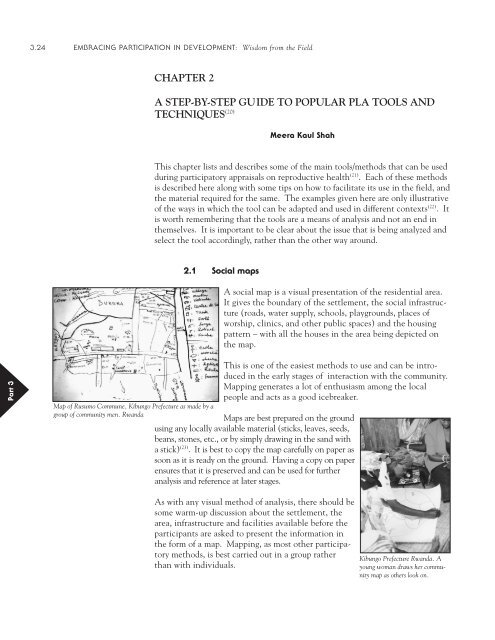PRA-Manual Embracing Participitation tools-only.pdf - PACA
PRA-Manual Embracing Participitation tools-only.pdf - PACA
PRA-Manual Embracing Participitation tools-only.pdf - PACA
Create successful ePaper yourself
Turn your PDF publications into a flip-book with our unique Google optimized e-Paper software.
3.24 EMBRACING PARTICIPATION IN DEVELOPMENT: Wisdom from the Field<br />
CHAPTER 2<br />
A STEP-BY-STEP GUIDE TO POPULAR PLA TOOLS AND<br />
TECHNIQUES (20)<br />
Meera Kaul Shah<br />
This chapter lists and describes some of the main <strong>tools</strong>/methods that can be used<br />
during participatory appraisals on reproductive health (21) . Each of these methods<br />
is described here along with some tips on how to facilitate its use in the field, and<br />
the material required for the same. The examples given here are <strong>only</strong> illustrative<br />
of the ways in which the tool can be adapted and used in different contexts (22) . It<br />
is worth remembering that the <strong>tools</strong> are a means of analysis and not an end in<br />
themselves. It is important to be clear about the issue that is being analyzed and<br />
select the tool accordingly, rather than the other way around.<br />
2.1 Social maps<br />
A social map is a visual presentation of the residential area.<br />
It gives the boundary of the settlement, the social infrastructure<br />
(roads, water supply, schools, playgrounds, places of<br />
worship, clinics, and other public spaces) and the housing<br />
pattern – with all the houses in the area being depicted on<br />
the map.<br />
Part 3<br />
Map of Rusumo Commune, Kibungo Prefecture as made by a<br />
group of community men. Rwanda<br />
This is one of the easiest methods to use and can be introduced<br />
in the early stages of interaction with the community.<br />
Mapping generates a lot of enthusiasm among the local<br />
people and acts as a good icebreaker.<br />
Maps are best prepared on the ground<br />
using any locally available material (sticks, leaves, seeds,<br />
beans, stones, etc., or by simply drawing in the sand with<br />
a stick) (23) . It is best to copy the map carefully on paper as<br />
soon as it is ready on the ground. Having a copy on paper<br />
ensures that it is preserved and can be used for further<br />
analysis and reference at later stages.<br />
As with any visual method of analysis, there should be<br />
some warm-up discussion about the settlement, the<br />
area, infrastructure and facilities available before the<br />
participants are asked to present the information in<br />
the form of a map. Mapping, as most other participatory<br />
methods, is best carried out in a group rather<br />
than with individuals.<br />
Kibungo Prefecture Rwanda. A<br />
young woman draws her community<br />
map as others look on.














